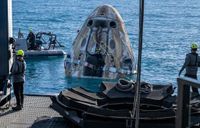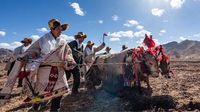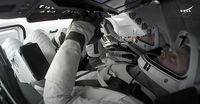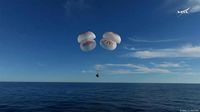NASA astronauts Suni Williams and Butch Wilmore, who bravely endured a remarkable nine-month stay aboard the International Space Station (ISS), returned to Earth on March 18, 2025. The duo, along with fellow astronauts Nick Hague and Aleksandr Gorbunov, splashed down in a SpaceX Dragon capsule off the Florida coast at 5:57 PM Eastern Time. This mission was originally planned as an eight-day excursion but spiraled into an extraordinary example of resilience and scientific dedication due to technical challenges with their initial spacecraft, Boeing's Starliner.
The Dragon spacecraft's journey home began early that Tuesday morning when the crew undocked from the ISS, kicking off a 17-hour trip back to Earth. In a display of adept engineering, the Dragon performed multiple orbit-lowering maneuvers before re-entering Earth's atmosphere and executing a parachute-assisted splashdown near Tallahassee, Florida. A recovery ship swiftly came to collect the capsule, ensuring a safe extraction of the astronauts.
As they emerged from the capsule one by one, assisted by medical personnel, officials expressed their relief and joy at their safe return. NASA's Acting Administrator, Janet Petro, reflected this sentiment, stating, “We are thrilled to have Suni, Butch, Nick, and Aleksandr home after their months-long mission conducting vital science, technology demonstrations, and maintenance aboard the ISS.” Indeed, Williams and Wilmore had made substantial contributions during their extended stay, which was a significant departure from their planned brief mission.
The missions were fraught with complications beginning soon after their launch aboard the Starliner in June 2024. Reports indicated that the Starliner encountered a series of technical issues, such as helium leaks and propulsion malfunctions, which led NASA to deem the craft unsafe for their return. Although the Starliner successfully returned to Earth in September 2024, Williams and Wilmore remained at the ISS, extending their stay significantly beyond the original mission duration. This adjustment transformed their mission from a mere test flight into a prototypical case study of the agency’s contingency planning capabilities.
Throughout their time in space, Williams set a record for the total spacewalking time by a female astronaut, amassing an impressive 62 hours and 6 minutes. During the lengthy mission, they engaged in various scientific efforts, including spacewalks, collecting surface samples, and conducting biological experiments concerning plant growth and stem cell technology for medical advances. Their work has been described as critical not just for the ISS but for future space exploration endeavors.
Interestingly, the prolonged mission did not escape political scrutiny. Former President Donald Trump made headlines by emphasizing the need for the astronauts' swift return, alleging that Biden had “abandoned” them for political reasons. This resulted in intensified discussions surrounding NASA's mission timelines and the effective management of the astronauts' safety. Such claims prompted greater public interest in the astronauts' plight and increasingly critical views toward Boeing's Starliner program.
The astronauts were greeted enthusiastically upon their return to Florida. Ground teams celebrated their successful splashdown with cheers, and footage revealed Williams and Wilmore joyfully embracing and capturing the moment with their fellow team members. Post-mission, they will undergo thorough medical assessments before reuniting with loved ones—a much-anticipated moment after nearly ten months in isolation away from Earth.
The urgency of their return would also be highlighted by the arrival of a new crew (Crew-10) just days earlier, reinforcing the cyclical nature of astronaut rotations aboard the ISS. These rotations maintain the continuity needed for ongoing scientific research and operations in space while illustrating the delicate balance of logistical planning in space exploration.
Despite facing unpredictable challenges, both Williams and Wilmore remained focused on their tasks at hand and adapted to their extended stay with remarkable professionalism. As they shared updates about life aboard the ISS, they became not just ambassadors of scientific inquiry but also symbols of human perseverance in the face of adversity.
Now back on solid ground, enthusiastic reactions from their communities have emerged, underscoring the impact of their journey. In certain places, celebrations erupted, and public displays of gratitude and excitement unfolded as friends and family welcomed these brave explorers back home.
As the dust settles from this mission, the value of NASA’s ongoing work and the intertwined futures of human exploration and technology are as clear as ever. The contributions made by Williams, Wilmore, Hague, and Gorbunov will serve as a cornerstone for upcoming ventures in the realm of space exploration, expanding understanding not only of terrestrial phenomena but of the very nature of life amid the stars.
Ultimately, these astronauts exemplify the courage and spirit that propel humankind toward new frontiers. Their story will continue to inspire future generations of explorers, driving aspiration and innovation in the field of science and beyond.





